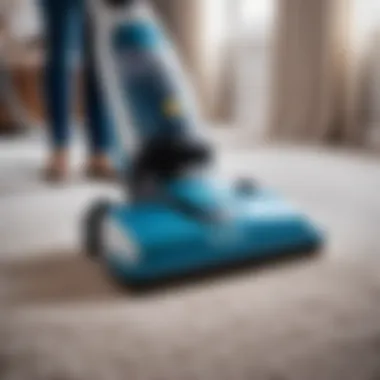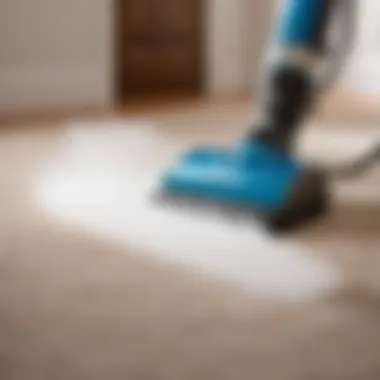Materials:
- White vinegar: 2 cups
- Baking soda: 2 tablespoons
- Liquid dish soap: 1 tablespoon
- Hydrogen peroxide: 1/2 cup
- Clean cloths
- Spray bottle
- Vacuum cleaner
- Scrub brush
- Gloves
DIY Steps:
To effectively deep clean a carpet contaminated with dog urine, follow these detailed instructions:
-
Blotting: Start by blotting up as much of the urine as possible with clean cloths. Avoid rubbing to prevent spreading the stain.
-
Vinegar Solution: Mix 2 cups of white vinegar with 2 cups of warm water and add to a spray bottle. Spray the affected area generously.
-
Baking Soda Application: Sprinkle baking soda over the vinegar solution and let it sit for about 20 minutes to absorb odors.
-
Scrubbing: Create a paste with 1 tablespoon of liquid dish soap and 1/2 cup of hydrogen peroxide. Gently scrub the paste into the carpet fibers.
-
Rinse and Dry: Blot the area with a clean cloth soaked in cold water to rinse out the cleaning solution. Allow the carpet to air dry completely.
Technical Aspects:
- Tools: Vacuum cleaner, spray bottle, scrub brush, gloves
- Timing: Total cleaning process may take 1-2 hours depending on carpet size
- Techniques: Blotting, using DIY cleaning solutions, gentle scrubbing
DIY Project Process:


Follow these sequential steps for an efficient deep cleaning process:
- Start by gathering all necessary materials and tools in one place.
- Begin by blotting up the urine stain to prevent it from setting deeper into the carpet fibers.
- Prepare the vinegar solution and apply it generously to the affected area, ensuring full coverage.
- Allow the solution to sit for the recommended time to effectively neutralize odors.
- Continue with the baking soda application to absorb any remaining smells.
- Gently scrub the carpet with the paste mixture to lift stubborn stains.
- Rinse out the cleaning solution thoroughly with cold water and allow the carpet to air dry completely.
Troubleshooting Tips:


- If the odor persists, repeat the cleaning process or consider professional cleaning services.
- Avoid using hot water, as it can set the stain and odor further into the carpet.
- Test any cleaning solutions on a small, inconspicuous area of the carpet first to ensure compatibility.
Understanding the Issue


Dog urine contamination on carpets is a common issue faced by pet owners, requiring meticulous attention to detail and specific cleaning techniques for effective removal. Understanding the impact of dog urine on carpets is crucial in addressing not just the visible stains but also the lingering odors and potential health risks associated with such contamination. By delving into the chemical composition of dog urine and elucidating the health hazards it poses, homeowners are empowered to take proactive measures to ensure a clean and hygienic living environment.
Impact of Dog Urine on Carpets
Chemical Composition of Dog Urine
The chemical composition of dog urine, which includes urea, uric acid, ammonia, and creatinine, contributes to its distinct odor and staining properties on carpets. Uric acid, in particular, forms hard-to-remove crystals that adhere to carpet fibers, leading to stubborn stains and persistent odor issues. Understanding the composition of dog urine is essential as it determines the effectiveness of cleaning solutions in breaking down these compounds for successful stain and odor removal. While the acidity of urine aids in the breakdown of organic matter, it also poses challenges due to its corrosive nature, requiring suitable cleaning products for safe and thorough carpet restoration.
Health Risks Associated with Urine Contamination
Urine contamination on carpets poses various health risks, including the proliferation of bacteria and pathogens that can trigger respiratory problems and allergies. Additionally, the presence of ammonia in urine vapors can irritate the respiratory tract, particularly in individuals with existing bronchial issues or sensitivities. Understanding the health hazards associated with urine contamination underscores the importance of prompt and thorough cleaning to mitigate potential risks and safeguard the well-being of household members, especially pets and children.
Challenges in Cleaning Dog Urine from Carpets
Penetration into Carpet Fibers
The penetration of dog urine into carpet fibers presents a major challenge in deep cleaning efforts, as the liquid seeps beyond the surface, reaching the backing and padding of the carpet. This not only exacerbates staining but also facilitates bacterial growth, resulting in foul odors that are difficult to eliminate. Addressing the penetration of urine requires targeted cleaning methods that effectively penetrate the carpet layers to lift and neutralize the contaminants, ensuring comprehensive sanitation and odor control.
Persistent Odor
Persistent odor stemming from urine contamination is a common issue, attributable to the presence of uric acid crystals that release foul-smelling compounds over time. Even after visible stains are removed, lingering odors can persist, creating an unpleasant indoor environment. Tackling persistent odors necessitates specialized odor-neutralizing techniques that target the source of the smell, inhibiting further emission and restoring freshness to the carpet. By recognizing the challenges posed by persistent odors, homeowners can adopt strategic cleaning approaches to achieve long-lasting odor control results.
Preparation for Deep Cleaning
To embark on the journey of deep cleaning a carpet contaminated with dog urine, thorough preparation is essential. Preparation sets the stage for an effective cleaning process. It involves gathering necessary supplies and taking safety precautions to ensure a successful outcome. By dedicating time to preparation, you significantly increase the efficiency and effectiveness of the cleaning process.
Gathering Necessary Supplies
White Vinegar
White vinegar plays a crucial role in deep cleaning carpets tainted with dog urine. Its acidic nature helps in breaking down the urine compounds, effectively neutralizing odors and stains. The key characteristic of white vinegar lies in its versatility and eco-friendly properties. Being a natural disinfectant, white vinegar is a popular choice for cleaning solutions due to its non-toxic and cost-effective nature. Its unique feature of combating bacteria and germs while being safe for pets and children make it an ideal component in the cleaning arsenal. However, one of its limitations is its strong odor, which may be an issue for some individuals though it dissipates once dry.
Baking Soda
Baking soda is another essential supply for deep cleaning carpets. Its abrasive texture aids in scrubbing out tough stains and absorbing odors. The key characteristic of baking soda is its odor-neutralizing properties, making it a valuable asset in combating unpleasant smells. It is a popular choice due to its gentle nature, ensuring it doesn't damage carpet fibers. Baking soda's unique feature of being a natural deodorizer effectively freshens up carpets without any harmful chemicals. However, excessive use may leave a white residue that requires thorough vacuuming to remove.
Cleaning Brush
A cleaning brush is a practical tool that assists in agitating cleaning solutions into the carpet fibers. Its key characteristic lies in its ability to loosen dirt and stains, facilitating their removal during the cleaning process. The unique feature of a cleaning brush is its versatility in cleaning various carpet textures and sizes effectively. It is a popular choice for its manual scrubbing action, ensuring deep penetration of cleaning agents into the carpet. However, improper use or excessive pressure may result in damage to delicate carpet fibers.
Absorbent Cloths
Absorbent cloths are indispensable for soaking up excess moisture and cleaning solutions from carpets during the deep cleaning process. The key characteristic of absorbent cloths is their high absorption capacity, allowing them to effectively lift and trap liquid residues from carpets. Their unique feature of being reusable provides an eco-friendly and cost-effective solution for practical cleaning. Absorbent cloths are a popular choice for their versatility in managing different spill sizes and types, ensuring thorough drying of carpets. However, inadequate or improper drying of cloths may lead to bacteria growth and unpleasant odors.
Methods of Deep Cleaning
In the realm of carpet maintenance, the significance of deep cleaning cannot be overstated. When dealing with a carpet contaminated by dog urine, effective deep cleaning methods are essential to not only remove visible stains but also to eliminate deep-seated odors for a truly fresh and clean finish. The methods explored in this article offer a comprehensive guide to tackling such challenging tasks, ensuring that your carpet remains pristine and odor-free.
Vinegar and Baking Soda Solution
Application and Dwell Time
Delving into the intricacies of the vinegar and baking soda solution, focusing on the application and dwell time reveals a crucial aspect of carpet cleansing. The unique blend of vinegar and baking soda acts as a powerful duo in breaking down urine stains and neutralizing odors effectively. The key characteristic of this solution lies in its natural and non-toxic properties, making it a popular choice for environmentally-conscious individuals seeking a safe yet potent cleaning option. The application and required dwell time of this solution allow it to penetrate the carpet fibers, loosening the stains and odors for easier removal. While the application and dwell time are effective in combatting urine contamination, it is important to note that prolonged exposure may affect certain carpet types differently, requiring a cautious approach to prevent any potential damage.
Rinsing and Drying
The final stages of the vinegar and baking soda cleaning process involve rinsing and drying, pivotal steps in ensuring a thorough clean. Rinsing the carpet after applying the solution is crucial to remove any residue and lingering odor traces, leaving behind a refreshed surface. The drying phase is equally essential as it prevents mold or mildew growth, maintaining the carpet's integrity. The unique feature of this method lies in its simplicity and accessibility, as vinegar and baking soda are readily available household items that can deliver impressive results. While the advantages of this approach include cost-effectiveness and natural cleaning properties, careful rinsing and thorough drying are imperative to prevent any potential issues that may arise from excess moisture.
Enzymatic Cleaners
How Enzymes Work
Exploring the realm of enzymatic cleaners unveils a fascinating aspect of carpet cleaning. Enzymes, specialized proteins, work by breaking down the organic compounds present in dog urine, effectively eradicating stains and odors at a molecular level. The key characteristic of enzymatic cleaners lies in their targeted approach, specifically designed to tackle urine-contaminated areas with precision. This scientific process ensures thorough sanitation and odor elimination, making enzymatic cleaners a favored choice for dealing with stubborn urine stains. The unique feature of enzymes lies in their ability to biochemically degrade urine residue, offering a deeper cleanse compared to conventional cleaning methods. While enzymatic cleaners are highly effective in removing urine stains, it is essential to consider any allergic reactions or sensitivities that may arise from their use, necessitating a diligent approach to application.
Effectiveness on Urine Stains
Assessing the effectiveness of enzymatic cleaners on urine stains underscores their unparalleled ability in treating such specific contaminants. Enzymes target the chemical compounds in urine, breaking them down into simpler, odorless substances, thereby eradicating both the visible marks and any persistent odors. The key characteristic of enzymatic cleaners in combating urine stains lies in their enzymatic activity, which ensures a thorough and lasting clean. In the realm of this article, enzymatic cleaners stand out as a beneficial choice due to their specialized formulation, which guarantees efficient stain removal and odor neutralization. However, it is important to note that the effectiveness of enzymatic cleaners may vary depending on factors such as application method and carpet material, requiring careful consideration to achieve optimal results.
Steam Cleaning
Procedure and Benefits
An in-depth look into steam cleaning unveils an innovative and efficient approach to deep carpet cleansing. The procedure involves using hot steam to break down stains and kill bacteria, resulting in a comprehensive and hygienic cleaning experience. The key characteristic of steam cleaning lies in its ability to penetrate deep into carpet fibers, extracting dirt, grime, and odors effectively. This method stands out as a popular choice in the article due to its sanitizing properties and eco-friendly aspects, making it a preferred option for households with pets. The unique feature of steam cleaning is its ability to remove allergens and bacteria, providing a healthier indoor environment. While the benefits of steam cleaning are evident in restoring carpets to their original state, it is essential to acknowledge potential drawbacks such as longer drying times and the need for specialized equipment, necessitating a balanced approach to achieve optimal outcomes.
Post-Cleaning Tips
Post-cleaning tips are crucial in ensuring the effectiveness of the carpet cleaning process, especially when dealing with dog urine contamination. This section focuses on essential practices and measures to maintain a fresh and hygienic environment post-cleaning. Implementing these tips will not only help in eliminating residual odors but also prevent future incidents of soiling. It is imperative to consider post-cleaning tips as an integral part of the overall carpet maintenance routine.
Odor Neutralization
Use of Baking Soda
Utilizing baking soda is a key element in odor neutralization after cleaning a carpet contaminated with dog urine. Baking soda, known for its absorbent and deodorizing properties, effectively helps in eliminating lingering odors. Its mild abrasive nature makes it gentle on carpets while effectively absorbing and neutralizing unpleasant smells. One of the main advantages of using baking soda is its natural and non-toxic composition, ensuring safety for households with pets and children. However, it is essential to note that excessive use of baking soda without proper vacuuming may lead to residue buildup, affecting the carpet's texture.
Baking Soda and Essential Oils
Combining baking soda with essential oils enhances the odor-neutralizing properties while infusing a pleasant fragrance into the carpet fibers. Essential oils such as lavender, eucalyptus, or tea tree not only mask odors but also provide antimicrobial benefits, contributing to a healthier indoor environment. The unique feature of this mixture lies in its ability to offer a customized scent profile based on individual preferences. However, it is important to conduct a patch test with essential oils to avoid any unforeseen reactions and ensure compatibility with the carpet material.
Preventive Measures
Regular Pet Stain Checks
Regular pet stain checks play a pivotal role in maintaining a clean carpet and early detection of potential accidents. By inspecting the carpet periodically, pet owners can identify and address stains promptly, preventing them from setting in or causing deep-seated odors. The key characteristic of regular stain checks is their proactive nature, enabling swift action to preserve the carpet's cleanliness and visual appeal. While beneficial in preventing extensive damage, a disadvantage of this measure could be the time and effort required for regular surveillance.
Proper Potty Training
Proper potty training for pets is fundamental in mitigating urine accidents and preserving carpet hygiene. Training pets to use designated areas for elimination minimizes the chances of contaminating carpets with urine. The key characteristic of effective potty training lies in consistency and positive reinforcement, encouraging pets to adhere to desired behaviors. While advantageous in preventing accidents, potty training may require patience and consistency to achieve desired results, depending on individual pet temperament and learning capability.





